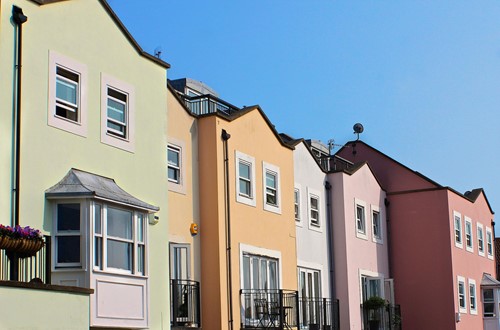
A common sight in historic metropolitan areas, row houses are an iconic example of multifamily housing structures. As their name suggests, row houses are oriented next to one another “in a row” and without a space in between. Each home is separate from the others, but the structure or building often shares a homeowners’ association or similar governing body.
Along with these key factors, there are plenty of characteristics that make row houses special.
Row house characteristics
Row houses can typically be identified by the following features:
- Multiple homes (at least three) are connected by shared walls on each side.
- Row homes are mostly uniform in appearance, sharing exterior features like windows and front doors. Row houses may have different colors, but all belong together aesthetically.
- Homes have their own individual door to the outside, unlike apartment or condominium buildings using a shared lobby.
- The buildings are typically low-rise, no taller than five stories.
In addition to aesthetic and structural elements, row houses often line entire streets or city blocks. In the United States, you’re likely to find row house neighborhoods in major urban centers with prominent historic districts, such as San Francisco, New York City, Boston and Baltimore.
Row house styles
While following the characteristics listed above, row house construction also falls into some basic architectural style categories. The main architectural styles of row houses include:
- Victorian row houses, which feature nineteenth-century details like stained-glass windows, bright paint colors, high-pitched roofs and ornate gables.
- Federal style row houses, a simple brick facade and three windows facing the street.
- Georgian row homes, which are usually two or three stories high, with brick facades and large windows to the street.
- Greek Revival style row homes, which have flat roofs and columns framing the entryway. They also have ornate cornices and narrow windows.
- Italianate row homes, which make up some of the most recognizable row homes: Brownstones. Italianate style features doors and windows with rounded tops, and frequently includes a bay window and front stoop.
Row houses are popular among many homeowners for their historical significance and unique architectural features. Many cities strive to maintain the integrity and appearance of row houses, so residents can continue to enjoy their aesthetic and charm for decades to come.
About the Author

Haruko Hata DRE #01824502
It’s not just about a house…it’s more about your life and dream….
My passion is to help my clients make their dreams come true and to make them happy. I love to see smiles on their faces, which makes me happy, too. That’s why I always strive to look at the positive potential of my clients’ dreams.